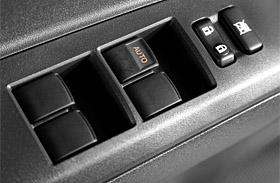| Program this light if you want. |
Cars today are jam packed with whistles and bells of every
manner. This is true both literally and figuratively. Of course we the
consumers have brought this upon ourselves because we like being surrounded by
fancy features.
The number of warning lights, chimes, beeps, and other
sights and sounds has reached a level where most people don’t even know what
some of them mean. Many times theses warning buzzers will sound at times that
can make the driver completely insane.
All new cars and trucks have many other features that are
now more automated then they used to be. Things like power door locks that lock
automatically when the vehicle exceeds five miles per hour, and unlock the
doors when the transmission is shifted back into park are very common on all
new cars.
Something most people do not know is that many of these features
can be customized in the way they operate. If you don’t like the way the seat
belt warning beeps at you every thirty second when you are not wearing your
seat belt, it can be set to a mode that only allows the light to come on once
after the car is first started and then shut off never to bother you again.
Things like automatic doors locks can be completely disabled
if you like. Maybe you want the doors to lock when you shift into drive instead
of when you hit 5 miles per hour. Most cars can have this type of thing changed
very easily.
Since everything on cars and trucks today is computer
controlled, it is very simple to give the computer different instructions on
how and when to automatically activate one system or another. Besides
programming things like power windows and door locks, other things can be
changed such as what size tire you have on the vehicle. The size of the tire
relates to function and accuracy of the speedometer. If you have a truck on
which you install bigger tires your speedometer is now going to be off a couple
of miles per hour. However, the bigger tire size can be programmed into the
computer that calculates speed and then your speedometer will be accurate
again.
Generally speaking there are two different ways to program
these features. The easiest and perhaps best way is to use a scan tool. This is
the device that the auto shop uses to communicate with the various computers on
your vehicle for diagnostic purposes. On today’s cars these tools can be used
for programming purposes as well. The factory scan tool that the dealerships
have will always have to most capability when it comes to making these types of
changes.
These tools can not only be used to program the function of a warning light or buzzer, but they can also be used to program major accessories. A feature such as cruise control can easily be added to a vehicle that did not come equipped with it from the factory. All that must be done is to have the switch installed in the steering wheel or the dash, and then use the scan tool to tell the engine control computer to enable cruise control programming. All of the other hardware the cruise control needs to operate is already there serving other purposes. With the correct switches and the correct programming, these components can then be used by the computer to provide cruise control.
The other way to make more minor changes to accessories is to follow a special programming sequence. Using things such as the ignition switch and power window or door lock
switches, or maybe the park brake lever or climate control buttons. An example of
how a programming sequences would work with these devices might be something
such as: turn on the ignition switch, hit the unlock button, turn the ignition
switch off, turn the ignition switch back on, hit the lock button, then pull
and release the park brake lever two times and listen for the dash to beep at
you. Once the dash beeps at you the vehicle is in programming mode and you can
push the fan speed up switch to make your selection. Once the selection is made,
turn the ignition switch off to reset the system.
This sounds like some kind of crazy secret code and perhaps
it is, but it provides a way to program these features without having to use a
special scan tool. Once in a while the owner’s manual will actually tell you
how to do some of these things but most of the time it won’t. These programming
sequences can usually be found online, but the best place to find them is in
the factory service manual. Sometimes even this will not have the information
on programming. Sometimes these things are only known to the engineers.
 |
| Watching a movie on this screen might be hazardous to your health. |
So if you have some whistle or bell on your vehicle that
annoys you, or just doesn't work the way you wish it would. Do a little
research and find out if it can be changed. If you paid so much money for this
car you ought to have the accessories work the way you would like them too.

















